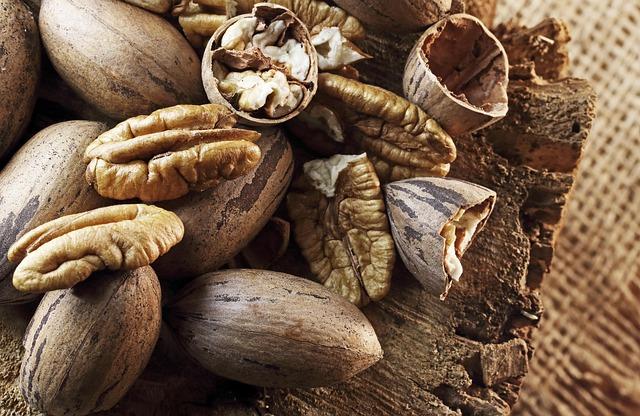In the heart of the Amazon rainforest, amid lush groves and vibrant biodiversity, lies a treasure that has captivated health enthusiasts and nutritionists alike: the Brazil nut. Not only is this remarkable nut a culinary delight, but it also stands as a formidable source of essential nutrients, notably selenium. As we delve into the world of raw brazil nuts,we uncover the delicate balance they strike between thier health benefits and potential toxicity. With the increasing popularity of superfoods, understanding the intricacies of Brazil nuts’ selenium content—how much we need, how to safely incorporate them into our diets, and the risks associated with excessive consumption—becomes paramount. Join us on a journey through the complexities of daily intake guidelines and toxicity concerns, as we explore the role of this nutritional powerhouse in our diets and its impact on health.
Exploring the Selenium Content in Raw Brazil Nuts
Brazil nuts are renowned for their exceptionally high selenium content, making them a standout choice for those looking to boost their micronutrient intake. Each nut can contain anywhere from 68 to 91 micrograms of selenium, which is significantly above the daily recommended allowance. This powerful antioxidant plays a crucial role in various bodily functions, including immune response, thyroid hormone metabolism, and reduction of oxidative stress. The variation in selenium levels can be attributed to factors such as soil composition in the regions where these nuts are harvested, emphasizing the importance of sourcing them from reputable suppliers.
While the benefits of selenium are numerous, moderation is key due to the potential toxicity associated with excessive intake. High doses of selenium can lead to selenosis, characterized by symptoms like gastrointestinal distress, hair loss, and fatigue. For most adults, a daily intake of 55 micrograms is sufficient, suggesting that consuming just one to two Brazil nuts daily can easily meet this requirement. However, individuals should be cautious not to overindulge. Here is a brief overview of the recommended intake and potential toxicity levels:
| Intake Level | amount (micrograms) |
|---|---|
| Recommended daily Intake | 55 |
| Toxicity Threshold | 400 |

Understanding Daily Intake Recommendations for Selenium
Selenium is an essential trace mineral that plays a crucial role in various bodily functions, including antioxidant protection, thyroid hormone metabolism, and immune system support. The recommended daily intake varies by age, gender, and life stage, making it vital to understand specific needs. Generally, adults should aim for 55 micrograms per day, while pregnant and lactating women require higher amounts to support fetal advancement and lactation.
Excessive consumption of selenium can lead to toxicity, a condition known as selenosis. While brazil nuts are a well-known source of selenium — with just a few nuts providing multiple times the daily requirement — moderation is key. Here are some critically important considerations regarding selenium intake:
- Daily Recommended Amounts: Understanding yoru personal daily requirements is vital.
- Signs of Deficiency: Fatigue, hair loss, and weakened immunity are common indicators.
- Symptoms of Toxicity: Nausea, diarrhea, and garlic breath may signal too much selenium.
To give a clearer picture of selenium intake recommendations, here’s a simplified table showing daily requirements based on different demographics:
| Group | Recommended Daily Intake (micrograms) |
|---|---|
| Adults | 55 |
| Pregnant Women | 60 |
| Lactating Women | 70 |
| Children (ages 1-18) | 20-55 |

Evaluating the Risk of Toxicity from Excessive Brazil Nut Consumption
The allure of Brazil nuts lies not only in their unique flavor and texture but also in their remarkable selenium content. This essential mineral plays a pivotal role in various bodily functions, including antioxidant defense and thyroid hormone metabolism. However, the very attribute that makes Brazil nuts a nutritional powerhouse can also lead to potential health risks when consumed in excess. Regularly exceeding the recommended dietary allowance of selenium, which is approximately 55 micrograms per day for adults, may result in toxicity. Symptoms of selenium excess can include gastrointestinal distress, hair loss, and neurological damage, underlining the importance of moderated consumption.
To better understand the potential risks associated with Brazil nut intake, it’s crucial to consider the selenium concentration within these nuts, which can vary significantly based on their source. On average, just one Brazil nut can contain between 68 to 91 micrograms of selenium. This wide range makes it essential for consumers to monitor their daily servings closely. To aid in assessing how many nuts are safe to incorporate into a diet while avoiding toxicity, consider the following:
| Daily Serving | Selenium Intake (approx.) | Risk Level |
|---|---|---|
| 1 Brazil Nut | 68-91 µg | Safe |
| 2 Brazil Nuts | 136-182 µg | Risk of Excess |
| 3 Brazil Nuts | 204-273 µg | High Risk |
Given that selenium accumulates in the body over time, maintaining a balanced intake is crucial. It’s advisable for individuals to limit consumption to one or two Brazil nuts per day while seeking alternative sources of selenium to meet their nutritional needs. This approach will not only promote better health but also mitigate the risk of toxic effects associated with excessive selenium intake.

Practical Tips for Incorporating Brazil Nuts Safely into Your Diet
Incorporating Brazil nuts into your diet can be a nutritious choice, provided it’s done thoughtfully and in moderation. To enjoy the health benefits without risking excessive selenium intake, consider the following tips:
- Moderate Your Intake: Limit your consumption to 1-3 Brazil nuts per day. This amount is generally sufficient to reap the benefits without surpassing the recommended daily selenium allowance.
- Pair with Other Foods: Use Brazil nuts as a topping on salads or mix them into yogurt, allowing you to savor their rich flavor and nutrition alongside other healthy ingredients.
- Storage Matters: Store your brazil nuts in a cool, dry place, preferably in an airtight container, to prevent them from going rancid while preserving their nutrients.
Being mindful of how you incorporate Brazil nuts into your diet also involves keeping an eye on your overall dietary selenium intake.Here are some points to consider:
| Food Source | Selenium Content (mcg per serving) |
|---|---|
| Brazil Nuts (1 nut) | 68-91 |
| Tuna (1 can) | 63 |
| Egg (1 large) | 15 |
| Brown Rice (1 cup, cooked) | 19 |
By being aware of other selenium sources in your diet, you can enjoy Brazil nuts without exceeding the recommended daily intake. Balance is key, ensuring you get the nutrients you need while minimizing any potential risk of toxicity associated with excessive selenium consumption.
In Conclusion
the analysis of raw Brazil nuts reveals a interesting intersection of nutrition and caution. While their extraordinary selenium content can offer important health benefits, it also underscores the importance of moderation. As we navigate the complexities of dietary choices, understanding the balance between utilization and risk is essential. Whether you relish them as a snack or incorporate them into your meals, being mindful of your intake can ensure you enjoy the advantages of Brazil nuts while minimizing potential toxicity concerns. By staying informed and listening to our bodies, we can savor the goodness of this unique nut without crossing the fine line into excess. As always, knowledge is the key to a healthier and more balanced diet, empowering us to make choices that nourish our well-being.






